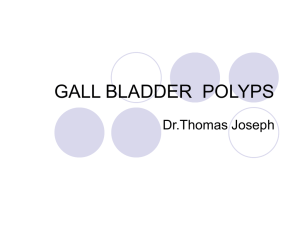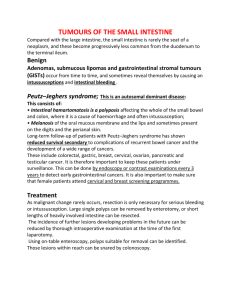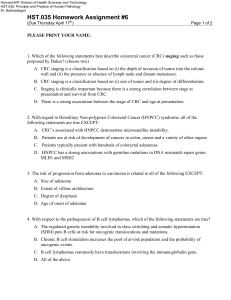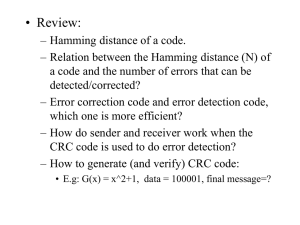Harvard-MIT Division of Health Sciences and Technology HST.121: Gastroenterology, Fall 2005
advertisement
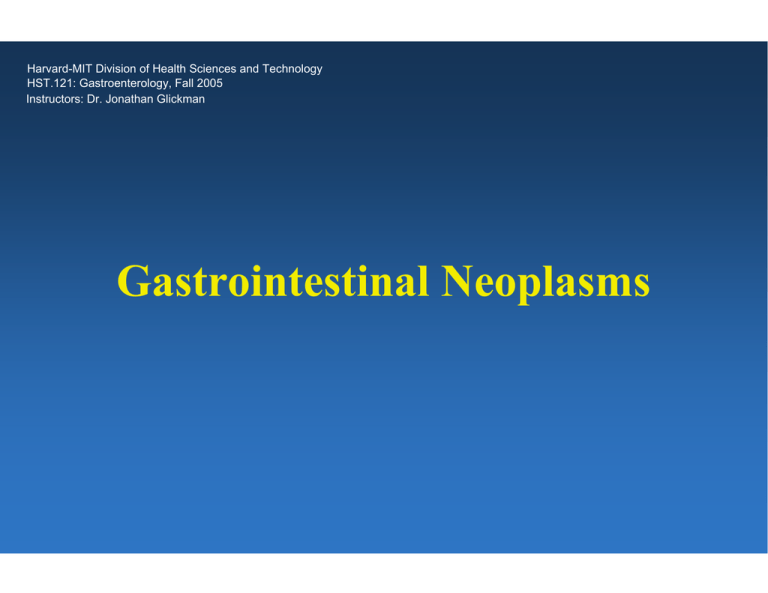
Harvard-MIT Division of Health Sciences and Technology HST.121: Gastroenterology, Fall 2005 Instructors: Dr. Jonathan Glickman Gastrointestinal Neoplasms Neoplastic Diseases of the Stomach • Mucosal polyps – Hyperplastic (regenerative) polyps – Cystic fundic gland polyp – Inflammatory fibroid polyp – Polyposis syndromes – Adenomas • Gastric adenocarcinoma – Variants: Adenosquamous; lymphoepithelial; hepatoid; parietal cell • Neuroendocrine tumors • Stromal tumors • Lymphomas Overview of the Lecture • Epithelial tumors – – – – – Epithelial polyps Colorectal ACA Gastric ACA Esophageal ACA Esophageal SCC • Neuroendocrine tumors • Lymphomas • Gastrointestinal stromal tumors The Art of Terminology! • A tumor is a mass lesion without reference to tissue composition or malignant potential • GI tumors typically present as protrusions of mucosal tissue into the lumen (polyps); Polyps may have a broad base (sessile polyps) or be attached to the wall by a stalk (pedunculated polyps) • Over the years, the term tumor has almost become synonymous with a neoplastic growth The Art of Terminology • A neoplasm is the new (new onset) growth (overgrowth) of a specific cell or tissue type, which may or may not form a tumor • Based on their natural history, neoplasms may be benign, malignant, or locally aggressive • If the new growth consists of benign indigenous cell or tissue elements, it may be called a hamartoma or a hyperplasia The Art of Terminology • In the GI tract, dysplasia implies the presence of pre-malignant epithelial abnormalities (this is not necessarily true for other organs) • Dysplasia has a cytological spectrum from mild to severe (or from low-grade to high-grade) • Carcinoma indicates the presence of severe dysplasia, which may be confined by the basement membrane (carcinoma-in-situ) or invade through the basement membrane (invasive carcinoma) Epithelial Polyps • Inflammatory polyps – Inflammatory (pseudo)polyps – Sporadic juvenile polyps • Hamartomatous polyps – Juvenile polyposis syndrome – Peutz-Jeghers syndrome • Hyperplastic polyps • Adenomas Juvenile Polyps and Polyposis • Juvenile polyps consist of abnormal epithelial glands nested in an inflammatory background • Sporadic polyps (also called retention polyps) are typically found in the rectosigmoid of children presenting with blood in stools • Juvenile polyposis syndrome may be sporadic or familial (AD) and is associated with an increased risk of ACA and extraintestinal manifestations Hamartomatous Polyps • Polyps consist of indigenous epithelial elements with an arborizing muscular framework and little to no inflammation • Peutz-Jeghers syndrome is an AD disease with gastrointestinal hamartomatous polyps and mucocutaneous pigmented macules • Molecular defect: STK11/LKB1 gene (serine-threonine kinase) • PJS patients have an increased risk of gastro-intestinal neoplasms and neoplasms of many other organs including ovaries, testes, cervix, breast, thyroid, biliary tree, and urogenital tract Hyperplastic Polyps • The most common type of colorectal polyp • Hyperplastic polyps are typically small and sessile protrusions of “hypermature” colonic epithelium with little inflammation and no muscular component • Large hyperplastic polyps are much less common, but may be associated with an increased risk of dysplasia and ACA • “Serrated neoplasia pathway”- methylation silencing of tumor suppressor genes Adenomas • Adenomas are benign but dysplastic epithelial neoplasms of the GI tract • Adenomas are common lesions, occuring in 25-50% of individuals over the age of 60 • Most adenomas (~90%) are colonic • Most colonic adenomas (~75%) are in the rectosigmoid • Most adenomas (~75%) are single Classification of Adenomas • Adenomas are divided into three types based on their glandular architecture –Tubular (most common) –Villous (least common) –Tubulovillous • The above three types are histological variants of the same neoplastic process Familial Adenomatous Polyposis • AD disease characterized by progressive development of hundreds of adenomatous polyps (primarily colonic) • Incidence of 1 in 10,000 live births • Inherited in 80% of cases • Associated with 100% risk of ACA • Associated with mutations of APC gene (5q21) APC Genotype-FAP Phenotype Associations • Mutations in exons 3, 4, and distal 15 are associated with Attenuated FAP (also known as Flat Adenoma Syndrome) • Mutations in codons 1309/1328 of exon 15 are associated with an early aggressive FAP • Mutations in distal portion of exon 15 are weakly associated with Gardner’s Syndrome (FAP + desmoids + osteomas + other) • Mutations between exons 9 and 15 are associated with CHRPE The APC Gene • APC is a basolateral membrane protein that functions as a tumor suppressor protein presumably through interactions with β-catenin (a cytoskeletal protein that can exert a suppressive effect on cellular proliferation through the Wnt signaling pathway) • Numerous mutations of the APC gene have been described in FAP; Somatic APC mutations are critical in sporadic colorectal carcinogenesis APC Gene in Colorectal Carcinogenesis Normal Epithelium APC gene (5q loss or mutation) Proliferative Epithelium Methylation Abnormalities Early Adenoma k-Ras gene (12p mutation) Intermediate Adenoma DCC/SMAD (18q loss) Late Adenoma p53 gene (17p loss) Invasive Carcinoma Other mutations Metastases Genomic Instability in CRC • Chromosomal instability (majority of CRCs): Allelic losses, translocations, and other gross chromosomal abnormalities in key regulatory proteins • Microsatellite instability (minority of CRCs): Increased intragenic mutations due to instability of short tandemly repeated DNA sequences (microsatellites) Microsatellite Instability (MSI) • Nucleotide mismatches that “normally” occur when DNA polymerase inserts the wrong base in the newly synthesized DNA are typically repaired by mismatch repair enzymes • Defects in the process of mismatch repair lead to MSI (instability in >40% of loci) • Mutations in DNA mismatch repair (MMR) genes (primarily MSH2 & MLH1) are found in sporadic CRCs with MSI and in families with HNPCC MSH2 MSH3 DNA mismatch MLH1 mismatch binding H2 S M MS H3 PMS1 recruit partners conformation change H1 ML H2 S M PM S1 MS H3 Modified from Fishel et al Cancer Research 61:7369;2001 Herediatry Non-Polyposis Colorectal Cancer Original International Collaborative Group criteria (the Amsterdam Criteria) Modified Amsterdam Criteria NCI Workshop (Bethesda Guidelines) 1. Three relatives with colorectal cancer (CRC), one a firstdegree relative of the other two 2. CRC involving at least 2 generations 3. >1 CRC diagnosed before the age of 50y • In very small families: 1. Two CRC's in first-degree relatives 2. CRC involving at least 2 generations 3. >1 CRC diagnosed before the age of 50y • In families with 2 first-degree relatives affected by CRC, the presence of a third relative with an unusually early onset of CRC or endometrial cancer • Cancer in families that fulfill Amsterdam criteria • Two HNPCC-related cancers • CRC or endometrial cancer before the age of 45 • CRC and a first-degree relative with CRC and/or HNPCCrelated cancer and/or colorectal adenoma; one of the cancers before the age of 45 and adenoma before the age of 40 • Right-sided CRC with "undifferentiated" histology before the age of 45 • Signet-ring-cell-type CRC before the age of 45 • Adenomas before the age of 40 Colorectal Adenocarcinoma (CRC) • In 1999, CRC was the third most common carcinoma and the third leading cause of cancer deaths in the US • Greater than 130,000 new cases per year • Rare before the age of 40 • M:F ratio of 1 (but ~2 for rectal cancers) • Risk factors: ? environmental, ? diet • Five-year survival ~65% in 1994 Pathology of CRC • Most CRCs are in the rectosigmoid • Left-sided tumors tend to produce “napkin-ring” lesions and present with obstruction • Right-sided tumors tend to be large and centrally necrotic polypoid masses • Most tumors are gland-forming and well- to moderatelydifferentiated; ~10% are mucinous • Survival generally related to depth of invasion, nodal status, and metastases Gastric adenocarcinoma • • • • Worldwide variation in incidence (e.g. high in Japan) Incidence falling in U.S. over last 50 years Most common 50-70 years, M>F Causative factors: – dietary carcinogens – familial – chronic inflammatory conditions • Aggressive tumors with poor prognosis (15% 5 year survival Genetic Progression in Gastric Neoplasia •5q21 deletion/APC inactivation •17p13 deletion/p53 mutation •MLH1 methylation Normal Metaplasia •C-met/HGF amplification/ overexpression •9p21 deletion/p16 inactivation •19q12 amplification/Cyclin E overexpression •18q deletion •16q22 deletion/E-cadherin loss •chromosomal deletions (1p, 1q, 7q, 13q) Dysplasia AdenoCa Gastric carcinoma- pathology • Location: antrum (70%)>lesser curvature, cardia (25%)>diffuse (5%) • Gross configuration: polypoid, ulcerating, or infiltrating • Intestinal type: gland formation, associated with intestinal metaplasia, dysplasia • Diffuse type: signet ring cells, arises directly from surface foveolar cells, not associated with environmental factors Esophageal carcinomas • Two major types –Squamous cell carcinoma –Adenocarcinoma • Squamous cell carcinoma more common worldwide • Incidence of adenocarcinomas rising in U.S., Western Europe, now accounts for 50% of esophageal malignancies in those regions Esophageal adenocarcinoma • Peak age 60-70 years, M>>F • Symptoms: dysphagia, weight loss • Arises in setting of Barrett’s esophagus (columnar metaplasia with goblet cells) in distal esophagus • Proceeds through dysplasia-carcinoma sequence • Microscopically similar to adenocarcinomas elsewhere in GI tract • Aggressive tumors; key to survival is early detection Esophageal squamous cell carcinoma • Incidence highest in Africa, Iran, China • Peak age: 55-65 years, M>F • Causative factors – – – – Alcohol, tobacco Corrosive esophagitis Achalasia ?HPV • Symptoms: dysphagia, weight loss • Aggressive tumors (10% 5 year survival) Neuroendocrine (carcinoid) tumors • Arise from neuroendocrine cells of gastrointestinal mucosa and its derivatives (e.g. lung, pancreas) • Variable clinical behavior but often slow-growing • Appendix most common site (35%) followed by ileum (20%) • Pathology: uniform cells with round nuclei, “salt and pepper” chromatin • Extra-appendiceal carcinoids frequently invade wall, metastasize Carcinoid syndrome • Only develops in patients with liver metastases • Tumors elaborate serotonin, plus histamine, others • Flushing, diarrhea, bronchoconstriction, valvular changes in right heart • Treatment: removal or ablation of metastasis or antagonism/suppression of circulating serotonin GI tract lymphomas • • • • Nearly all non-Hodgkin’s lymphomas (NHL) GI tract involved in 70% of patients with NHL Stomach most common site, followed by intestine and colon Nearly all B cell type, except for enteropathy associated T cell lymphoma (a/w celiac diseae) • MALT lymphoma: gastric lymphomas develop in setting of H. pylori infection (potentially treatable by H, pylori eradication) Gastrointestinal stromal tumors (GISTs) • Spindle cell neoplasms arising from interstitial cells of Cajal (pacemaker cells) • Most associated with activating mutations in c-kit tyrosine kinase; sensitive to treatment with inhibitor (Gleevec) • Variable aggressiveness • Prognostic factors: size, location, histologic grade • Distinguish leiomyomas (true neoplasms of smooth muscle) Other tumors • • • • • • Adenocarcinoma of small intestine, appendix Anal squamous cell carcinoma Mesotheliomas od peritoneum Melanoma (rectum, anus, esophagus) Lipoma (colon, stomach) Kaposi’s sarcoma

